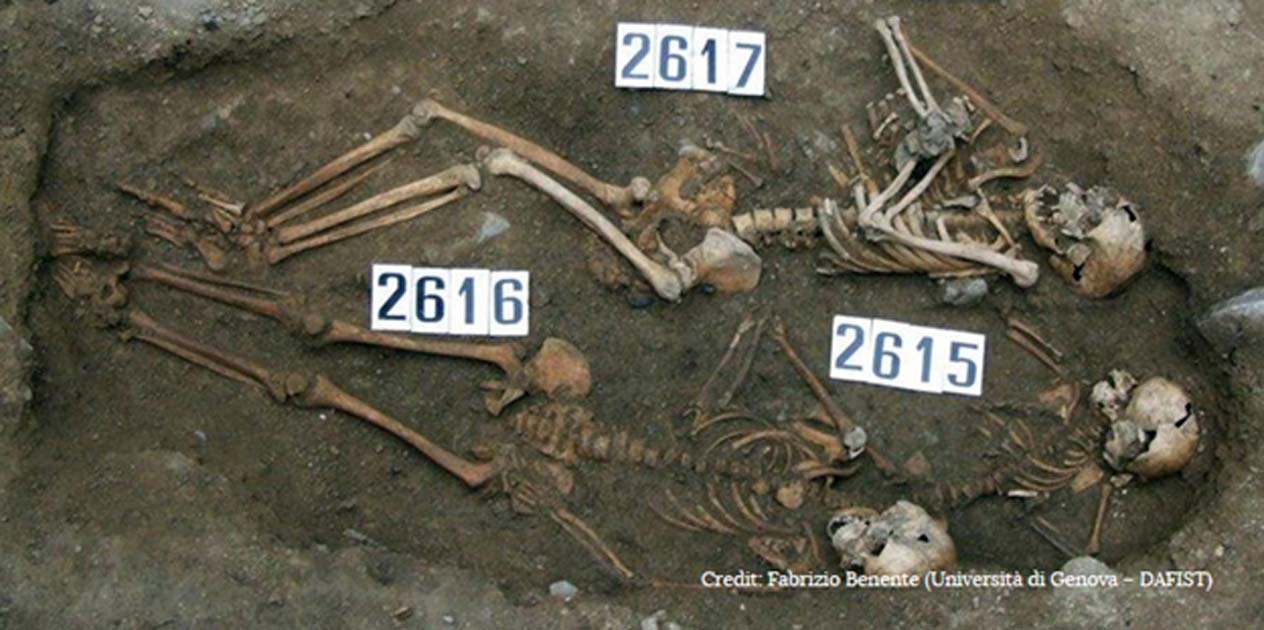New Details Emerge on the Black Death by Examining a Plague Victim and her Tragic Coffin Birth
We can only guess about the life and times of a young mother and two children buried with her, possibly felled by the first wave of the bubonic plague in the 1340s in Italy. They were all buried in a single grave excavated in 2006. We know she was expecting the birth of a baby. Later, after the putrefaction of her body and the placenta generated gases in her uterus, her dead body partially expelled the fetus, in what is known as a coffin birth.
An archaeological team that analyzed the skeletal remains of the bodies says the mother was 30 to 39 years old at the time of her death. The children, who may have been hers, were about 3 and 12. The fetus was about 38 or 40 weeks old. The researchers wrote that a post-mortem fetal extrusion, or coffin birth, is rare in the archaeological record.
The bodies were buried in a cemetery of the "ospitale" of San Nicolao di Pietra Colice, 45 miles (72.5 km) from Genova. It may have been a treatment center for people suffering communicable diseases. The woman and children buried together in the cemetery suffered from various ailments, evident to the researchers in the bones and teeth of the deceased.
- The Plague that brought down mighty empires is thousands of years older than thought
- The Bizarre Phenomenon of Coffin Births

(a) Skeleton of the adult female (b) Skeleton of the 12-year-old sub-adult (c) Skeleton of the 3-year-old sub-adult (d) Skeleton of the 38–40-week-old fetus. (Cesana, D., Benedictow, O.J., & R. Bianucci)
The team, headed by D. Cesana of the Università degli Studi di Genova, in Genova, Italy, published its findings in the journal Anthropological Science. They identified DNA evidence of the plague germ, Yersinia pestis, in the remains of the woman and children. The disease is spread by rodents and fleas.

The plague in Florence, 1348, as described in Boccaccio’s ‘Decameron’; etching by L. Sabatelli. (Wellcome Images)
These are the first bodies found from that era in the Liguria region of Italy. The finding of a multiple burial was especially telling because it is more likely than a single burial to be a plague event.
The researchers’ informative article explores how the plague spread in Europe via Italian merchants and their sailing ships that had ports in the Crimea. The plague first erupted east of Italy in a swath of land between the Caspian Sea and the Black Sea. One city in the region was Tana, where Genoese traders had a factory. The Mongols laid siege to Tana, driving the Italian traders west to the city of Kaffa, where they had a factory and trading center. As the article states:
“Kaffa was in its turn besieged, and it was in the autumn of 1346 that the Black Death broke out among the beleaguering army. Later, it broke out in the town until halted by cold winter weather. In the early spring, a few Genoese and Venetian galleys left Kaffa for their home cities, while the main fleets of galleys remained to fight in order to secure possession of the town, eventually successfully, and returned as usual to their home cities in the autumn, in November. The galleys that left Kaffa early in the spring were highly probably the source of the contamination of Constantinople in early May 1347.”
- Scientists Revive Ancient Plague to Learn Clues About Epidemic that Wiped Out Half of Europe
- What is a fetus doing inside the coffin of a 17th century mummified bishop?

Spread of the Black Death (from the original outbreak of the plague to its end), 1346-1353. (Cesana, D., Benedictow, O.J., & R. Bianucci)
As the traders continued back to ports along the way between the Crimea and the Italian mainland, “spreading the Black Death all the way,” the plague erupted in 1348 all around the Mediterranean coast from the Levant at the eastern end, to Portugal at the western end, and south in Africa and north across Italy, Greece, and Turkey. The plague in 1348 also reached London, far to the north. Within a year, it would break out as far north as Scandinavia and south into Egypt, killing as much as 60 percent of the populations where it struck.
The skeletal remains in the multiple burial in Liguria will help researchers better understand the disease, as the authors wrote:
“The theory of the epidemiology and dynamics of spread of the first phase of the Black Death in Italy from the original mainland epicentres can now be tested, using Tuscany and Umbria and the southern region Emilia Romagna, regions for which superior data exists.”
Top image: The remains of a mother and fetus were buried alongside those of two other children in the early days of the Black Death in Italy, however researchers cannot say for certain that they died of the plague. Source: Fabrizio Benente/University of Genova - DAFIST
By Mark Miller

















